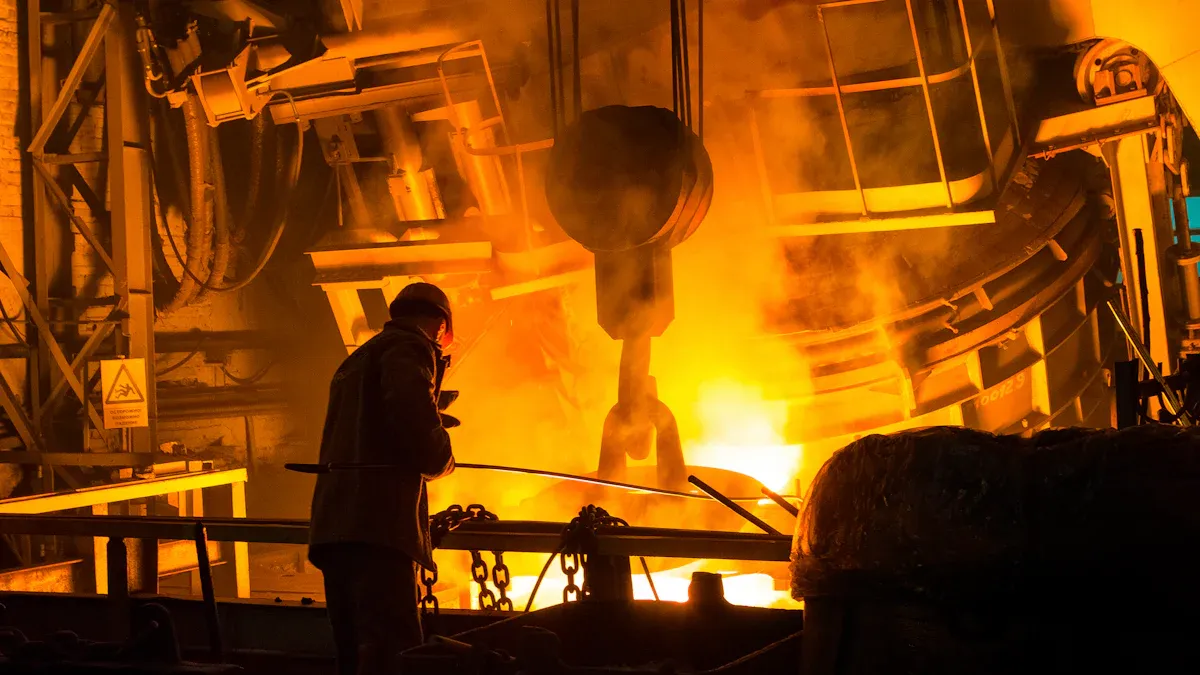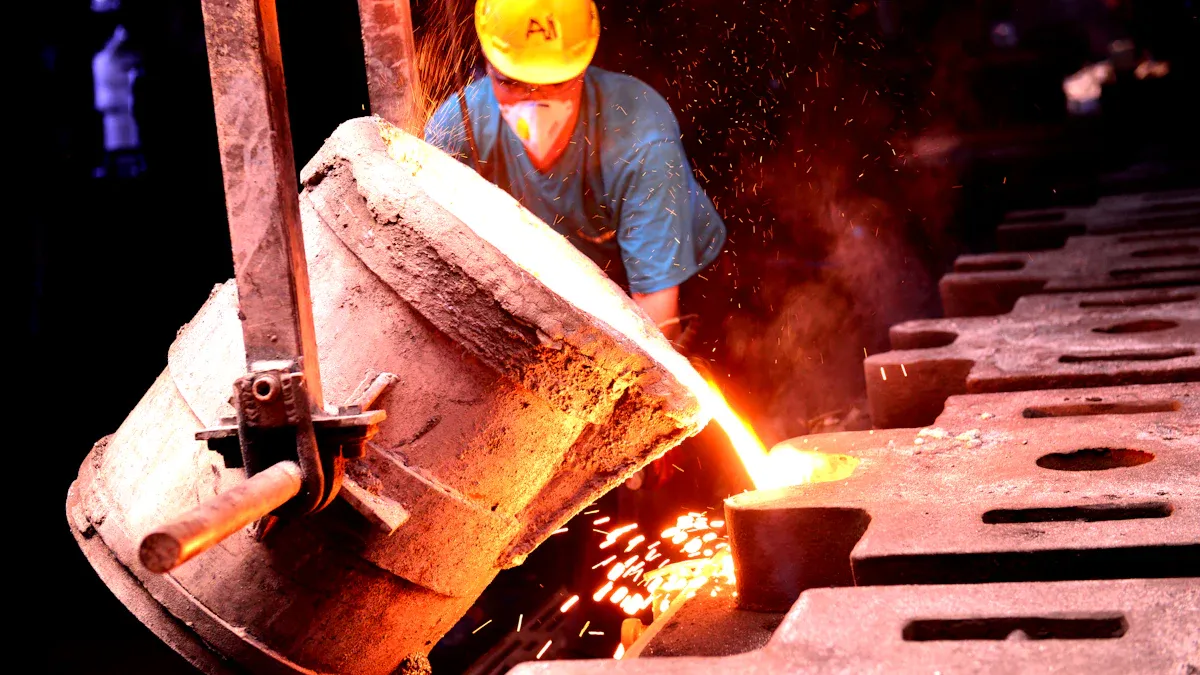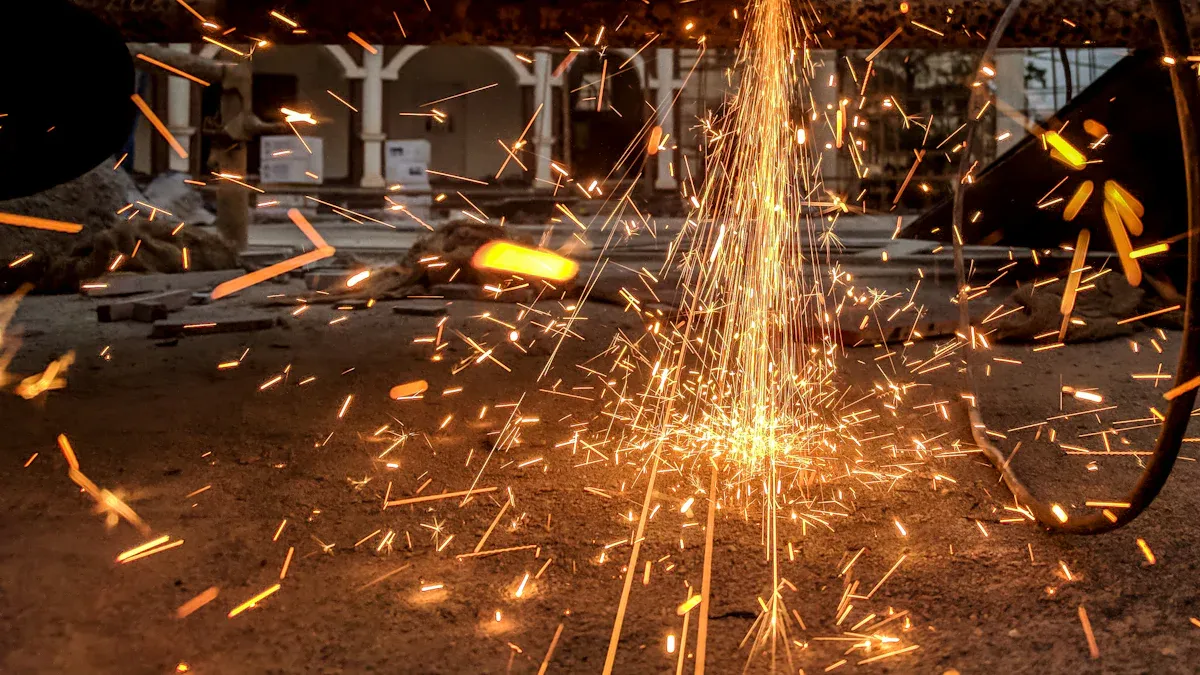
Tin Bronze Precision Foundry is essential in modern industries, particularly through tin bronze investment casting. Its corrosion resistance and machinability make it indispensable for shipbuilding and automotive applications. Companies like Ningbo Pingheng Machinery Co., Ltd. leverage advanced techniques to meet growing demands. By 2025, trends like automation and energy efficiency will redefine the Tin Bronze Precision Foundry.
Tin Bronze and Its Applications
Key Properties of Tin Bronze Alloys
Tin bronze alloys stand out due to their exceptional properties, making them a top choice for industrial applications. These alloys offer:
- High wear resistance, ensuring durability in demanding environments.
- A low friction coefficient, which reduces energy loss in moving parts.
- Excellent corrosion resistance, especially in marine and saline conditions.
- The ability to endure high loads and temperatures, making them reliable under stress.
Compared to other alloys, tin bronze combines strength, hardness, and ductility. For instance, it surpasses statuary bronze in strength and aluminum bronze in flexibility. This unique balance allows it to perform well in both intricate designs and heavy-duty applications.
Applications Across Aerospace, Automotive, and Marine Industries
Tin bronze plays a vital role in several industries. Its versatility and reliability make it indispensable in the following areas:
| Industry | Application | Reason for Use |
|---|---|---|
| Automotive | Bearings and bushings | High mechanical strength and excellent wear resistance |
| Marine | Ship propellers and rudders | Resists seawater corrosion, reducing maintenance needs |
| Marine | Fittings in saline environments | Ensures durability and reliability in harsh conditions |
In aerospace, tin bronze is used for components like gears and bushings, where strength and precision are critical. Its ability to withstand extreme conditions makes it a trusted material in these high-performance sectors.
Benefits of Tin Bronze in Precision Casting
Tin bronze offers several advantages in precision casting. Its excellent casting properties allow for intricate designs, making it ideal for complex components. The addition of tin enhances strength, hardness, and corrosion resistance, ensuring durability in harsh environments. Components like bearings and gears benefit from its low friction and wear resistance, which improve efficiency and reduce maintenance costs.
Moreover, using recycled copper and tin in the casting process supports sustainability. It reduces the need for mining, lowers energy consumption, and minimizes greenhouse gas emissions. Companies like Ningbo Pingheng Machinery Co., Ltd. leverage these benefits to deliver high-quality solutions across industries. This approach not only meets performance demands but also aligns with eco-friendly practices.
Innovations in Tin Bronze Precision Foundry

3D Printing for Complex Casting Molds
3D printing is revolutionizing the way molds are created in the Tin Bronze Precision Foundry. This technology allows manufacturers to produce intricate and highly detailed patterns that were once impossible with traditional methods. Companies like Hoosier Pattern are leading the way by using sand to 3D print molds, which enhances precision and reduces material waste.
Here’s how 3D printing benefits the casting process:
- Faster production: Patterns can now be created in days instead of weeks.
- Cost savings: It eliminates the need for expensive machining or CNC milling.
- Improved accuracy: High dimensional precision ensures better casting quality.
- Design freedom: Complex geometries are no longer a challenge.
This innovation not only improves efficiency but also supports sustainability by minimizing scrap and energy consumption.
Smart Manufacturing and Automation
Automation is transforming the Tin Bronze Precision Foundry by enhancing consistency and speeding up production cycles. Robots now handle tasks like pouring molten metal, reducing human error and improving precision. Ningbo Pingheng Machinery Co., Ltd. has embraced these advancements to meet high industry standards.
Smart manufacturing also includes simulation software, which helps identify potential issues like air pockets before production begins. Data monitoring further optimizes the process by analyzing trends and improving mold performance. These technologies ensure high-quality components while adapting to changing demands.
Advanced Tin Bronze Alloy Development
Recent studies have shown significant advancements in tin bronze alloys. For example, researchers have developed medium-entropy bronze alloys with varying tin content. Adding tin has transformed the microstructure, improving hardness, yield strength, and wear resistance.
Another breakthrough involves Nickel Aluminum Bronze alloys. A small addition of tin refined their grain structure, increasing hardness by 69% and tensile strength by 28.4%. These innovations highlight the potential of tin to enhance the performance of alloys, making them more durable and efficient for industrial applications.
Sustainability in Tin Bronze Casting

Eco-Friendly Practices in Foundries
Tin bronze foundries are adopting eco-friendly practices to reduce their environmental impact. These practices focus on recycling, energy efficiency, and reusing materials.
| Practice | Description |
|---|---|
| Recycling | Using recycled copper and tin reduces the need for mining, lowering energy consumption. |
| Energy Efficiency | Companies report reduced greenhouse gas emissions and energy costs through proactive maintenance. |
| Reusing Materials | Leftover bronze can be melted down and reused, minimizing waste and raw material expenses. |
Recycling has been a cornerstone of the foundry industry for centuries. Metalcasters have long remelted old metals to create new objects, a practice dating back to 3200 B.C. This commitment to sustainability ensures that foundries minimize waste while maintaining high-quality production standards.
Recycling and Waste Reduction in Casting
Recycling and waste reduction play a vital role in tin bronze casting. Foundries save money and reduce environmental harm by reusing scrap materials. Leftover bronze from previous casts is melted down and repurposed, minimizing waste and lowering raw material costs.
Companies like Ningbo Pingheng Machinery Co., Ltd. use precision casting techniques to reduce material loss. This approach ensures consistent quality, making it reliable for industries like shipbuilding and power generation. Proper scrap management also guarantees high-quality materials in every batch, further enhancing sustainability.
Energy-Efficient Casting Technologies
Energy-efficient technologies are transforming the tin bronze casting process. Foundries now use recycled copper and tin to minimize mining needs, which lowers energy consumption. Optimized mold designs and production cycles also reduce operational costs and energy use.
Bronze bushings, known for their durability and low friction, improve machinery efficiency. This leads to significant energy savings during operation. Manufacturers also benefit financially by refining mold designs and simplifying production cycles. These practices save time, reduce costs, and prevent delays through proactive equipment maintenance.
By adopting these technologies, foundries not only lower their carbon footprint but also enhance their competitiveness in the market.
Digital Transformation in Precision Casting
Artificial Intelligence for Quality Control
Artificial intelligence (AI) is reshaping quality control in the Tin Bronze Precision Foundry. By analyzing data in real time, AI ensures that every casting meets high standards. It identifies patterns and predicts potential defects before they occur. This proactive approach saves time and reduces waste.
Advanced sensors and imaging technologies play a key role in this transformation. Automated systems inspect molds and castings with incredible precision. Machine vision detects surface imperfections, while ultrasonic testing uncovers internal flaws. These tools work together to deliver flawless components, improving reliability across industries.
Manufacturers benefit from AI’s ability to streamline processes. With fewer defects and faster inspections, production cycles become more efficient. This technology not only enhances quality but also boosts overall productivity.
IoT for Real-Time Process Monitoring
The Internet of Things (IoT) brings real-time monitoring to the casting process. Sensors embedded in equipment collect data on temperature, pressure, and other critical factors. This information is sent to a central system, allowing manufacturers to track operations as they happen.
IoT helps identify issues early, preventing costly delays. For example, if a mold’s temperature deviates from the ideal range, the system alerts operators immediately. Quick adjustments ensure consistent results and reduce material waste.
By providing detailed insights, IoT enables continuous improvement. Manufacturers can analyze trends, refine processes, and adapt to changing demands. This technology keeps the Tin Bronze Precision Foundry competitive in a fast-paced market.
Digital Twins for Enhanced Process Optimization
Digital twins are virtual replicas of the casting process. They provide real-time feedback, helping manufacturers optimize operations before production begins. This technology simulates every step, from mold design to final casting, ensuring precision at every stage.
Digital twins offer several advantages:
- They detect potential problems early, reducing rework and material waste.
- Simulations reveal bottlenecks and inefficiencies, saving time and resources.
- Heat distribution analysis minimizes defects, improving product quality.
By integrating digital twins, foundries gain better control over their processes. This innovation enhances efficiency and supports sustainable practices, making it a game-changer for the industry.
Market Trends and Future Opportunities
Demand for Personalization and Small-Batch Production
The demand for personalization and small-batch production is reshaping the tin bronze casting market. Customers now expect products tailored to their specific needs, and manufacturers are stepping up to meet these expectations. Digital technologies and 3D printing have made this shift possible. These tools allow foundries to create custom molds quickly and efficiently, adapting to unique designs without compromising quality. This flexibility has become a game-changer for industries like automotive and marine, where precision and customization are essential.
Small-batch production also offers cost advantages. By producing only what’s needed, manufacturers reduce waste and save resources. This approach aligns with the growing focus on sustainability, making it a win-win for businesses and the environment.
Growth in Key Sectors: Aerospace, Automotive, and Marine
Several industries are driving the growth of tin bronze precision castings. These include:
- Automotive: Bearings, bushings, and other components benefit from tin bronze’s durability and wear resistance.
- Marine: The material’s corrosion resistance makes it ideal for ship propellers, rudders, and fittings.
- Electronics: Tin bronze is increasingly used in electrical connectors and switches.
- Construction: Its strength and reliability make it a popular choice for heavy-duty applications.
- Industrial: High-performance machinery relies on tin bronze for its ability to withstand extreme conditions.
This growth is expected to continue as industries prioritize materials that offer both performance and sustainability.
Challenges and Opportunities in the Global Market
The global tin bronze casting market faces several challenges. Fluctuating prices of tin and copper can increase production costs, making it harder for manufacturers to stay competitive. Environmental concerns also bring stricter regulations, pushing foundries to adopt greener practices. Additionally, alternative materials like aluminum-bronze are emerging as strong competitors.
Despite these hurdles, the market holds significant opportunities. It is projected to grow at a compound annual growth rate (CAGR) of 5.2% over the next five years. Rising demand in automotive, marine, and electrical sectors will drive this expansion. Innovations in alloy development and sustainable practices further enhance the market’s potential. Regions like North America and Europe are expected to lead this growth, thanks to advanced technology adoption and a focus on eco-friendly solutions.
The future of tin bronze precision casting looks promising, driven by innovation and sustainability. Key trends include:
- Embracing 3D printing for complex designs and faster production.
- Using automation and AI to improve precision and efficiency.
- Adopting eco-friendly practices like recycling and waste reduction.
Stakeholders should act now by integrating these technologies and sustainable methods to stay competitive.
FAQ
What makes tin bronze ideal for precision casting?
Tin bronze offers excellent wear resistance, corrosion protection, and machinability. These properties make it perfect for creating durable, intricate components.
How does Ningbo Pingheng Machinery Co., Ltd. ensure quality in casting?
The company uses advanced investment casting techniques and adheres to strict national standards. This guarantees high-quality solutions for industries like automotive and marine.
Can tin bronze castings be customized for specific industries?
Yes, Ningbo Pingheng Machinery Co., Ltd. tailors castings to meet unique industry needs. They work with various materials, including tin bronze, silicon brass, and stainless steel.
